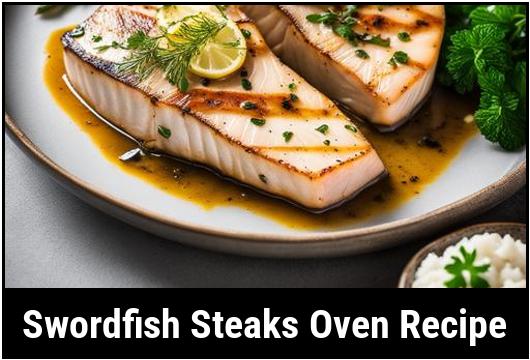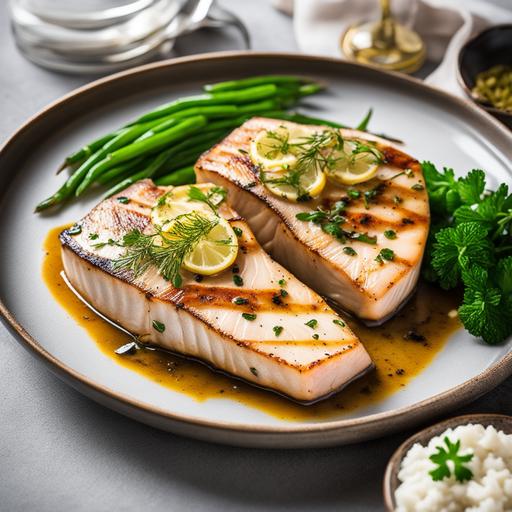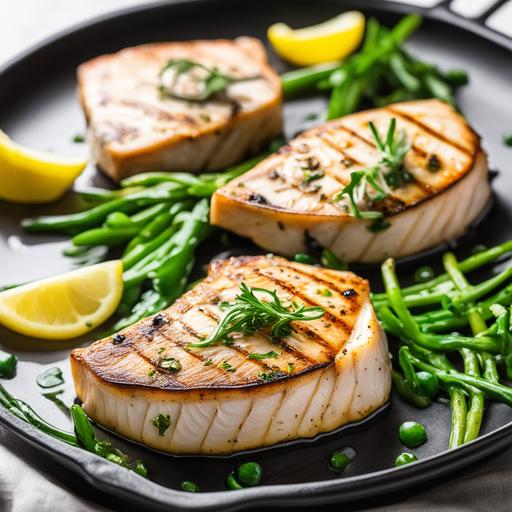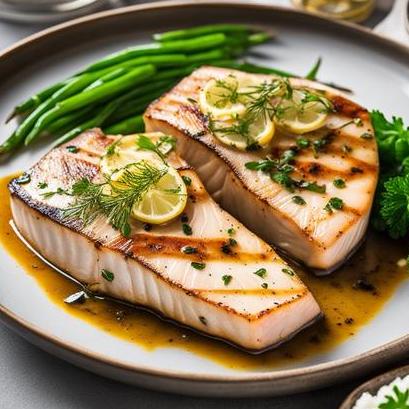
Swordfish Steaks Oven Recipe: A Delightful And Flavorful Dish
Are you ready to elevate your culinary skills and treat your taste buds to a delectable seafood delight? Look no further than swordfish steaks cooked to perfection in the oven. With its firm texture and succulent flavor, swordfish is a true delicacy that will impress even the most discerning palate. In this comprehensive guide, we will delve into the world of swordfish steaks, exploring their selection, preparation, and a mouthwatering oven recipe that will leave you craving for more.
Understanding Swordfish: The King of the Sea
Before diving into how to make the perfect swordfish steaks, it’s worthwhile to understand what makes this fish so unique. Swordfish, known as the "King of the Sea," hails from warm and temperate waters around the world. It possesses a meaty and firm texture, reminiscent of a perfectly cooked tenderloin. The flavor is mild yet distinctive, with sweet undertones that make it a favorite among seafood lovers.
Selecting the Finest Swordfish Steaks
When it comes to selecting swordfish steaks, freshness is key. Look for steaks that have a vibrant and bright appearance, with no signs of discoloration or dullness. The flesh should be firm to the touch and have a pleasant fresh sea smell. Avoid steaks with any strong odor, as this is an indication of spoilage.
To ensure sustainability, choose swordfish that has been caught using methods that minimize harm to other marine life. Opt for swordfish that is certified by sustainable seafood initiatives or labeled as responsibly sourced. By doing so, you contribute to the preservation of our oceans for future generations to enjoy.
Cleaning and Preparing Swordfish Steaks

Before diving into the culinary adventure, begin by cleaning and preparing the swordfish steaks. Start by rinsing them under cold running water, removing any impurities or debris that may have accumulated during the preparation process. Pat the steaks dry using paper towels to ensure proper seasoning and browning.
Next, it’s time to remove the skin from the steaks, as it can add an unpleasant toughness to the final dish. Using a sharp knife, make a small incision at the edge of the skin and slowly work your way along the length of the steak, ensuring clean and precise cuts. Repeat this process for each steak, taking care to discard the skin properly.
Unleashing the Culinary Magic: Swordfish Steaks Oven Recipe

Ingredients:
-
4 swordfish steaks (approximately 6 ounces each)
-
2 tablespoons of olive oil
-
2 cloves of garlic, minced
-
1 teaspoon of lemon zest
-
Juice of 1 lemon
-
1 teaspoon of dried oregano
-
Salt and pepper to taste
Instructions:
-
Preheat your oven to 400°F (200°C) and line a baking dish with aluminum foil for easy cleanup.
-
In a small bowl, combine the olive oil, minced garlic, lemon zest, lemon juice, dried oregano, salt, and pepper. Stir vigorously to create a flavorful marinade.
-
Place the swordfish steaks in the prepared baking dish, ensuring they have enough space between them for even cooking.
-
Drizzle the marinade over the steaks, making sure to coat each one thoroughly. Massage the marinade into the flesh, allowing it to penetrate and infuse the flavors.
-
Let the marinated steaks rest at room temperature for approximately 20 minutes, allowing the flavors to meld and enhance the taste.
-
Once rested, transfer the baking dish to the preheated oven and cook the swordfish steaks for approximately 10-12 minutes, depending on the thickness of the steaks. Flip the steaks halfway through the cooking process to ensure even browning.
-
To determine if the swordfish steaks are cooked to perfection, use a meat thermometer to check the internal temperature. The ideal reading should be between 145-150°F (63-66°C). Remember that the fish will continue to cook slightly once removed from the oven, so it’s crucial not to overcook it.
-
Once cooked to your desired doneness, remove the baking dish from the oven. Tent the steaks loosely with aluminum foil and let them rest for a few minutes to allow the juices to redistribute, resulting in a moist and succulent final dish.
-
Serve the swordfish steaks hot, garnished with fresh herbs or a squeeze of lemon juice. Consider accompanying them with a citrusy quinoa salad or roasted vegetables for a well-rounded and flavorful meal.
Tips and Variations to Elevate Your Swordfish Steaks

1. Experiment with Seasonings:
While the recipe above offers a delightful blend of Mediterranean flavors, feel free to experiment with various seasonings to suit your taste preferences. Consider replacing the dried oregano with fresh herbs like thyme or rosemary for an earthy aroma. A touch of chili flakes can add a delightful kick for those who appreciate a bit of spice.
2. Grilling Option:
If you prefer the smoky flavors imparted by the grill, you can adapt this recipe for grilling. Prepare the marinade as directed and marinate the steaks for at least 30 minutes. Preheat the grill to medium-high heat and oil the grates. Grill the swordfish steaks for approximately 4-5 minutes per side, or until they reach the desired internal temperature.
3. Lemon Butter Sauce:
For an extra burst of flavor, you can prepare a tangy lemon butter sauce to accompany your swordfish steaks. Simply melt 4 tablespoons of unsalted butter in a small saucepan over medium heat. Add the juice of a lemon and a pinch of salt and whisk until well combined. Drizzle this rich and velvety sauce over your cooked steaks, taking them to the next level of culinary excellence.
Doneness Checks: Ensuring Perfectly Cooked Swordfish Steaks

Determining the doneness of a swordfish steak can be a challenging task, as overcooking can lead to dryness and toughening of the flesh. While the recipe above provides a general guideline, checking the internal temperature with a meat thermometer is the most foolproof way to achieve perfectly cooked steaks.
The ideal temperature for swordfish is around 145-150°F (63-66°C). This will ensure that the fish is cooked through while maintaining its moisture and tenderness. Insert the meat thermometer into the thickest part of the steak, making sure not to touch the bone if present. Once the desired temperature is reached, remove the steaks from the oven or grill immediately to prevent overcooking.
In Conclusion
With its luxurious texture and captivating flavors, swordfish steaks are a culinary masterpiece that deserves a place on your dinner table. Whether you’re a novice cook or a seasoned chef, this comprehensive guide has equipped you with the knowledge and skills to select, clean, prepare, and cook swordfish steaks to perfection.
By utilizing the delicious oven recipe provided and experimenting with your own variations, you can easily create a dining experience that will amaze and delight your guests. So, don your apron, fire up your oven or grill, and embark on a gastronomic journey with swordfish steaks that will leave a lasting impression. Bon appétit!
Sources
FAQS On Swordfish Steaks Oven Recipe
What Is The Best Oven Temperature For Cooking Swordfish Steaks?
The ideal oven temperature for cooking swordfish steaks is 400 degrees Fahrenheit (200 degrees Celsius). This temperature ensures that the fish cooks evenly and retains its moisture, resulting in a juicy and flavorful steak.
How Long Should I Cook Swordfish Steaks In The Oven?
The cooking time for swordfish steaks in the oven depends on the thickness of the steak. As a general rule, for 1-inch thick steaks, you should cook them for about 10-12 minutes. For thicker steaks, you may need to increase the cooking time slightly. It is always recommended to check the internal temperature with a meat thermometer to ensure it reaches at least 145 degrees Fahrenheit (63 degrees Celsius).
Should I Marinate Swordfish Steaks Before Cooking Them In The Oven?
While marinating swordfish steaks is not necessary, it is highly recommended as it can enhance the flavor and tenderize the meat. You can prepare a simple marinade using ingredients like lemon juice, olive oil, minced garlic, and your choice of herbs and spices. Allow the steaks to marinate in the fridge for at least 30 minutes or up to 2 hours for more intense flavor.
How Can I Prevent Swordfish Steaks From Drying Out In The Oven?
To prevent swordfish steaks from drying out in the oven, it’s important not to overcook them. It is best to follow the recommended cooking time and check the internal temperature to ensure it doesn’t go beyond 145 degrees Fahrenheit (63 degrees Celsius). Basting the steaks with melted butter or olive oil before baking can also help lock in moisture while adding richness to the flavor.
Can I Use Frozen Swordfish Steaks For This Oven Recipe?
Absolutely! You can use frozen swordfish steaks for this oven recipe. Simply thaw the steaks in the refrigerator overnight or under cold running water. Make sure to pat them dry before cooking. Adjust the cooking time slightly if the steaks are still partially frozen. It’s important to note that fresh swordfish steaks generally yield better results in terms of taste and texture, but frozen steaks can still be delicious when prepared properly.



